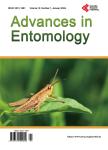Predatory Potential of Phytoseiulus macropilis(Banks)Preying on Tetranychus urticae Koch(Acari:Phytoseiidae,Tetranychidae)
作者机构:Postgraduate ProgramUniversidade Federal de Lavras-UFLALavrasBrazil Empresa de Pesquisa Agropecuária de Minas Gerais-EPAMIG Sul/EcoCentroLavrasBrazil Universidade Federal do Pampa-UNIPAMPARio Grande do SulBrazil Departamento de Ciencias ExatasUniversidade Federal de Lavras-UFLALavrasBrazil
出 版 物:《Advances in Entomology》 (昆虫学(英文))
年 卷 期:2018年第6卷第2期
页 面:134-147页
学科分类:1002[医学-临床医学] 100214[医学-肿瘤学] 10[医学]
主 题:Agricultural Acarology Functional Response Numerical Response Biological Control
摘 要:The two-spotted spider mite, Tetranychus urticae Koch (Tetranychidae), is considered one of the most important species of pest-mites because it is cosmopolite and polyphagous. This species has been described as attacking over 1,100 plant species in 140 families of economic importance. On the other hand, Phytoseiulus macropilis (Banks) (Phytoseiidae) is a predatory mite of group I, specialist as predatory mite from the Tetranychus genus. Thus, the objective of this work was to evaluate predatory potential of P. macropilis in its different stages—nymphs, female and male adults—preying on T. urticae also in different stages—eggs, larvae, nymphs, and adults—and to know the functional and numerical responses in lab studies. Both the experiments were carried out on arenas made of Jack-bean leaflets’ discs [Canavalia ensiformis (L.)—Fabaceae] with 3 cm in diameter over agar-water at 3% inside 5 cm in diameter uncapped Petri dishes. To know the predatory activity, forty T. urticae and one predatory mite were placed in each arena with the respective phases of the developmental life cycle to be evaluated. To know the potential of predation, the no killed mites were counted after 24 hours. To know the functional and numerical responses, immature T. urticae in densities of 1 to 300/arena were offered for P. macropilis. The results for the predatory potential showed that larvae and male adult of T. urticae were the most killed stages, and the female predatory mites were the one that consumed most prey. The functional response showed a positive and significant correlation, suggesting a type II functional response (convex), a cyrtoid curve rising at a decreasing rate to a plateau, where the consumption remains constant regardless of prey density.



